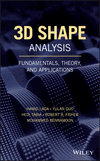Conclusions and Perspectives
Summary
Our journey in the 3D shape analysis world started with the preprocessing techniques, which take raw 3D data and transform them into a state that facilitates their analysis. This book looks at the correspondence and registration problem, which is an important aspect of 3D shape analysis. It is central to many applications including 3D reconstruction, deformation and interpolation, statistical analysis, and growth modeling and analysis. 3D models are just one type of digital representations of the world. People take images and videos, draw sketches, and describe the world with words and text. These modalities are treated independently, with most research focused on one modality. One trend to foresee in the future is how to jointly analyze and process multi-modal and heterogeneous visual and textual data. By doing so, one can search and retrieve relevant information independently whether it is a text document, a 3Dmodel, a depth scan, a sketch, an image, or a video.



